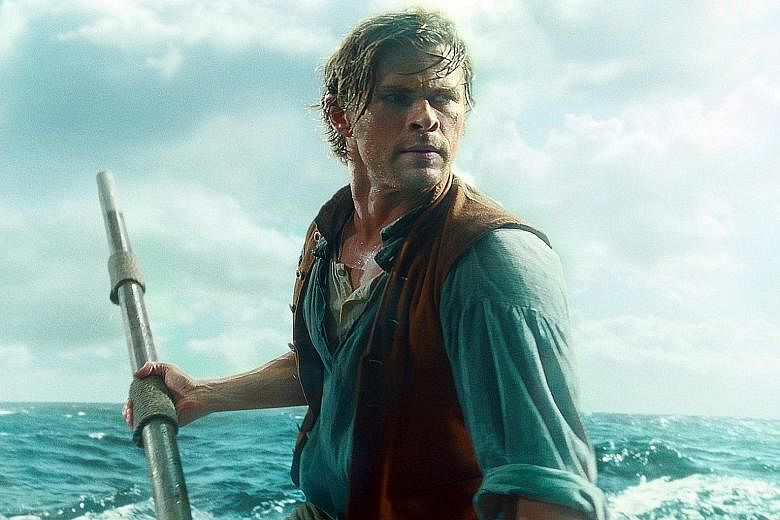Few people know that Moby Dick, Herman Melville's 1851 literary masterpiece, was inspired by the dramatic true story of a ship attacked by a whale in 1820 and the survival ordeal of its crew, who were lost at sea for months after.
Using firsthand accounts by survivors Owen Chase and Thomas Nickerson, the second of which surfaced only in 1980, author Nathaniel Philbrick wrote his bestseller In The Heart Of The Sea: The Tragedy Of The Whaleship Essex, which won the prestigious National Book Award for Nonfiction in the United States in 2000.
Fifteen years later, it has finally been turned into a movie by Oscar- winning director Ron Howard after at least four other film-makers toyed with the project, most of them stumped by how to depict the whalers' struggle with the creature, says screenwriter Charles Leavitt.
Leavitt also reveals that Melville's insecurities about his writing meant completing Moby Dick - about a ship captain's obsessive quest to find the whale that destroyed his ship - became his own personal "white whale".
Speaking to Life and other media in New York, Philbrick and Leavitt say the gripping story of the Essex bounced around Hollywood for well over a decade.
Philbrick remembers his book first being optioned for a movie the fall it was published.
"There were a couple of offers and, in my innocence, I said, 'Wow, it could become a movie!'," he says.
"But only a small percentage of books that are optioned actually become movies, so I had all sorts of interest that would peak and then die."
In 2012, actor Chris Hemsworth took up the project. He showed the script to Howard, his director in Rush (2012), and soon Philbrick found himself being peppered with questions from the actor, who plays Chase, as well as the film-maker.
"At some point, I remember getting an e-mail saying, 'Chris Hemsworth wants to know how to throw a harpoon.' I think I gave a very evasive, non-helpful answer."
Philbrick's book was the first to use both Chase's account of events, which was well-known at the time, including by Melville, as well as Nickerson's.
He adds: "For a historian, that's gold, when you get two perspectives on it.
"Owen Chase's was a wonderful account. It was written with the help of a ghostwriter. It's amazingly revealing - he very accurately described whaling boat captains in Nantucket, how these are tough men who know all sorts of deprivations and that regular people would be appalled by their way of life."
The author praises Nickerson's telling of the story, which was discovered in an attic in Connecticut in 1980.
"It was written late in his life and it was in this composition book, the sort you could get at a stationery store, and he had handwritten it with sketches of this immense whale hitting a ship. It brings in elements of the story that Chase chose not to bring in, like the fact that Chase had an opportunity to kill the whale but didn't."
Nickerson, on the other hand, chose to leave out the single most harrowing detail of the stranded sailors' survival - that they were forced to cannibalise their dead so as not to starve.
He would also do the unthinkable and embark on another doomed whaling expedition with Essex captain George Pollard, who is portrayed in the film as becoming obsessed with finding the whale that attacked them.
In his screenplay, Leavitt also weaves in the story of another obsessive quest - that of Melville's to become as celebrated a writer as his mentor Nathaniel Hawthorne.
"I'd done a lot of research into Melville and he was a very tortured individual - he questioned his sexuality, his father had committed suicide and lost a fortune, and the family had gone from very wealthy to impoverished.
"He also doubted his own capability of being a great writer. Up till that point, he had found some success with earlier books such as Typee (1846). They were popular but they were dismissed as travel stories.
"He wanted to write something great and so this consumed him, it was almost like his white whale."
In The Heart Of The Sea also captures the dying embers of the whaling industry, which existed because whale blubber was prized as fuel for candles and lamps.
Men such as the crew of the Essex were pushed farther and farther out to sea - including the remote Pacific Ocean where the attack took place - because they had overfished more accessible waters.
There, the Essex crew were humbled by nature in the form of the sea as well as the whale.
Says Philbrick: "For me, what's interesting about the past is not just how different it is from today but how similar - nature is always the presiding force.
"We've been able to insulate ourselves from it for about 100 years - we've oil and all these luxuries - but now, we are going, uh oh, we may have sc***ed the planet."
•In The Heart Of The Sea is showing in cinemas here.

